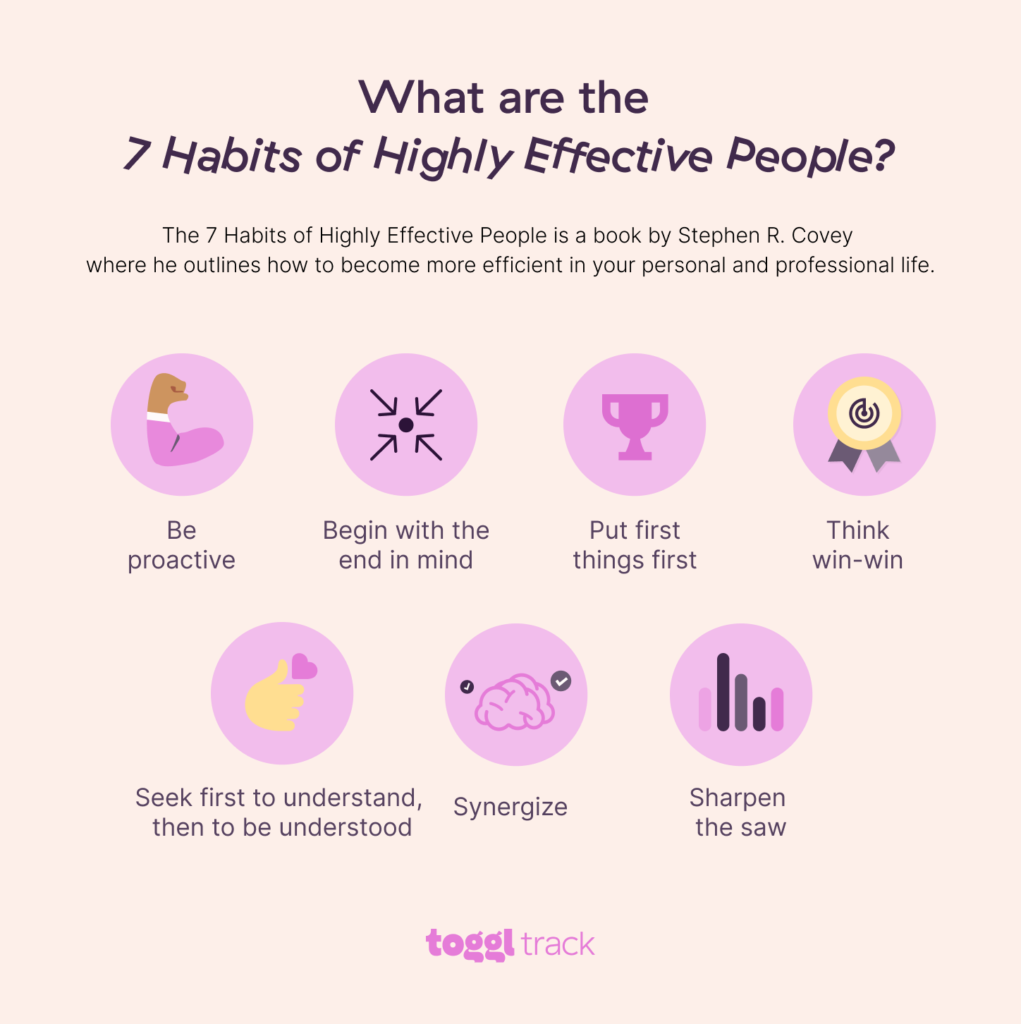What good is a journey without a destination? Sure, you might get to see a few things and go for a ride, but ultimately, the destination is the purpose.
This is one of the key principles in Stephen R. Covey’s influential book The 7 Habits of Highly Effective People. It relates to his second habit, “Begin with the End in Mind.” The premise is that with a clear goal and purpose, you can define and tackle actions that will help you reach that goal. In other words, you stop wandering aimlessly and get a clear sense of direction.
Today, we’ll explain what “begin with the end in mind” means in practical terms and how you can live this motto, too.
TL;DR — Key Takeaways
- The 7 Habits of Highly Effective People is a book by Stephen R. Covey where he outlines how to become more efficient in your personal and professional life.
- To begin with the end in mind means to envision a clear goal before starting so you can find out which steps to take to reach your destination.
- To effectively begin with the end in mind, first understand the end result, write a personal mission statement, and use SMART goals.
- The remaining six habits tie into the second one by forcing you to consider the small steps that build your path to the overarching end goal.
First…what are The 7 Habits of Highly Effective People?
The 7 Habits of Highly Effective People, published in 2004, is a popular book by Stephen R. Covey. For the past 20+ years, it’s been a popular resource for anyone who wants to solve problems in their own life, whether professional or personal.
- Be proactive. Take responsibility for your actions instead of blaming external circumstances. You’re in charge of your own life and shape it by making conscious choices. The idea is to act first before being acted upon.
- Begin with the end in mind. Define a clear end goal to work toward so you live purposefully and prioritize actions that make a difference.
- Put first things first. Prioritize tasks based on importance instead of urgency. Carefully choose those tasks that align with your long-term goals.
- Think win-win. In relationships, look for situations where every party involved can benefit somehow. This fosters collaboration, trust, and shared success.
- Seek first to understand, then to be understood. Lead with empathy, igniting your active listening skills and thinking carefully before you respond.
- Synergize. As a team, you can achieve more than an individual.
- Sharpen the saw. Invest in becoming a better version of yourself physically, emotionally, mentally, and spiritually. Practice these habits day-to-day, as it’s the only way to stay resilient and continue growing.

What does it mean to begin with the end in mind?
The second habit is arguably the most important for those who seek to reach their goals more quickly and easily. Once you envision a clear goal you want to achieve, you can create blueprints for specific actions necessary to get there.
For example, your end goal is to save $10,000 in 2025. To achieve it, you need to:
- Create an annual and monthly budget
- Determine how much you want to save and stick to it
- Set aside a certain portion of your monthly income
- Ask for a raise at your current job
- Find side gigs to earn X income per month
Covey’s second habit can be applied in professional and personal life and in a variety of situations, from something as life-altering as changing a career path to smaller things like choosing a new pair of sneakers.
This habit is powerful because it brings intentionality to decision-making. Making choices can be death by a thousand paper cuts. How often have you decided not to go anywhere because you don’t know what to wear?
Instead of wasting time making the right decision, the end goal dictates your choices. Distractions are minimal, and you can work faster since you have a clear vision of the outcome and you’re not bothered by making smaller decisions and milestones.
How to begin with the end in mind
Intentionality is excellent in theory, but many people struggle to apply it in real life. Below, we outlined some easy steps you can start with right now.
Understand the end result
Which of these two goals sounds easier to achieve?
- Get fitter next year.
- Lose 10kg by June 1. Be able to run five kilometers without significant difficulty. Have clean bloodwork by December 1.
The second goal is measurable, tangible, and easier to visualize.
Wanting “success” is one thing, but defining what that success means for you is crucial for effective goal-setting and crushing that goal. You’ll work toward the goal deliberately instead of shooting in the dark and hoping you hit something.
Write a personal mission statement
A personal mission statement is a short declaration of your purpose, values, and guiding principles. According to Covey, you can do this in just a few short steps.
- Reflect on your life’s purpose. Ask yourself questions such as “What do I want to accomplish in life (personally and professionally)? What values are most important to me? How do I want to be remembered by family, friends, colleagues, and my community?”
- Visualize your ideal life. Covey suggests imagining your own funeral or a significant event, such as a retirement party. Ask yourself what you would want others to think about, your biggest contributions, your roles in their lives (parent, leader, friend), and what legacy you want to leave.
- Define the roles you want to take on in life. For example, parent, partner, leader, mentor, and others. For each role, consider the principles you want to uphold and the goals to track.
- Identify your core values and principles. List the principles you want to live by, such as treating others with kindness. And notions such as compassion, integrity, growth, or creativity that resonate with you.
- Draft your mission statement. Combine all the items above into a cohesive and clear statement.
Remember, a personal mission statement is dynamic and can change along with your circumstances. Here is a good example of a personal mission statement based on these values:
“I will live a life of integrity and service, focusing on continuous growth and nurturing meaningful relationships. By prioritizing my values, I will strive to balance my roles as a family member, professional, and community contributor, ensuring my actions align with my purpose of inspiring others and leaving a positive legacy.”
Use SMART goals
SMART goals can be applied everywhere. From crushing your KPIs at work to situations in the real world, such as paying off a car loan. SMART stands for Specific, Measurable, Achievable, Relevant, and Time-bound, which are the elements of every effective goal.
Here is what it looks like in practice:
- Specific: Save money for a downpayment for a house this year.
- Measurable: I need $50,000.
- Achievable: I can save an additional $500 monthly on regular expenses and pick up a side job or two to make another $500.
- Relevant: It supports my decision to become a homeowner by the age of 40 and pay off the property by retirement.
- Time-bound: Achieve by December 31, 2025.
When your goals are SMART, your vision becomes clearer, and you’re better aligned with the second habit. The same goes for whatever your goals are.
What about the other six habits of highly effective people?
All seven habits of highly effective people work together to help you become the best version of yourself.
- Be proactive sets the foundations for maximizing efficiency by encouraging you to take responsibility and control your choices instead of blaming others.
- Put first things first focuses on the end goal so you can ignore short-term pleasures. For example, avoiding distractions such as doomscrolling on social media to help you achieve the bigger goal and do proper deep work.
- Think win-win forces you to collaborate with people who align with your values and purpose. It emphasizes collaboration and trust, which are all necessary for habit two to work well.
- Seek first to understand is all about communication and understanding others. You must connect with others and gain support for your goals to begin with the end in mind.
- Synergize amplifies habit two by using teamwork and collaboration. When you combine diverse perspectives and talents, you can create new, better solutions as you work toward your goal.
- Sharpen the saw gives you the resilience, clarity, and energy to pursue your end goal continuously. When you take good care of yourself, you ensure you’re aligned with the purpose from habit two.
How Covey’s habits apply to project management
Like real life, Covey’s seven habits work equally well in project management. The second habit means starting with a specific and clear goal in mind so everyone on the team knows what success looks like.
For example, if you aim to launch a new feature that solves a pain point for a subset of your target audience, you can break it down into deliverables and milestones. Everyone on your team knows what success entails, which steps to achieve it, what the target audience expects, and, ideally, who takes on which part of the workload.
Other habits, such as “Think Win-Win,” tie in nicely with project management. For example, each team member can think about the best coworker or department to collaborate with to achieve said goal. In our case, product management collaborates with customer success to translate customers’ needs into story points to develop the new feature.
“Sharpen the saw” can also be applied here. Only by investing in physical and mental well-being can the team be prepared mentally and physically to tackle complex workplace challenges.
Franklin Covey’s advice on time management
When you begin with the end in mind, you envision the goal the moment you start, helping you carve out the steps to success.
Another key part of Covey’s framework is time, as described in Covey’s time management matrix. To master your time, you need to prioritize important but not urgent tasks and focus on your long-term goals. This minimizes distractions and ensures that whenever you work towards your goal, time is spent intentionally and meaningfully.

In other words, molding yourself to Covey’s second habit means nothing without efficiently managing your time. To crush your personal and professional goals and truly begin with the end in mind, start with the second habit to build a strong foundation.
And when you need help managing your time, sign up for a free Toggl Track account.
Mile is a B2B content marketer specializing in HR, martech and data analytics. Ask him about thoughts on reducing hiring bias, the role of AI in modern recruitment, or how to immediately spot red flags in a job ad.



